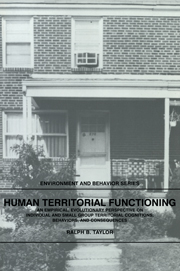 Human Territorial Functioning
Human Territorial Functioning Book contents
- Frontmatter
- Contents
- List of figures, tables, and boxes
- Series foreword
- Preface
- Acknowledgments
- 1 Introduction
- PART I ORIGINS OF HUMAN TERRITORIAL FUNCTIONING
- PART II A CONCEPTUAL MODEL OF HUMAN TERRITORIAL FUNCTIONING
- PART III TERRITORIAL FUNCTIONING IN SETTINGS OF VARYING CENTRALITY
- PART IV APPLICATIONS TO SOCIAL PROBLEMS
- PART V REVIEW AND PROSPECTS
- 13 Summary of the general line of argument and its implications
- 14 Future directions for research and application
- Index
14 - Future directions for research and application
Published online by Cambridge University Press: 05 February 2010
- Frontmatter
- Contents
- List of figures, tables, and boxes
- Series foreword
- Preface
- Acknowledgments
- 1 Introduction
- PART I ORIGINS OF HUMAN TERRITORIAL FUNCTIONING
- PART II A CONCEPTUAL MODEL OF HUMAN TERRITORIAL FUNCTIONING
- PART III TERRITORIAL FUNCTIONING IN SETTINGS OF VARYING CENTRALITY
- PART IV APPLICATIONS TO SOCIAL PROBLEMS
- PART V REVIEW AND PROSPECTS
- 13 Summary of the general line of argument and its implications
- 14 Future directions for research and application
- Index
Summary
This chapter addresses two matters: future conceptual issues deserving attention, and areas of potential application. One area of investigation is singled out with regard to the former: time. A detailed look at one area may be more fruitful than providing a laundry list of areas deserving investigation. Moving over to practical concerns, three potential areas of research application are highlighted. First, the role of explicit territorial arrangements in interior residential settings as a way of reducing or managing household stress is explored. To develop such an intervention fully, territorial concepts would need to be merged with concepts from family therapy. Second, the possibility of disorder reduction through a privatizing of streetblocks is considered. There have already been some efforts in this direction in St. Louis, but a more complete implementation and evaluation of such an arrangement is needed. And third, a resource conservation program involving feedback, reward, and a territorializing strategy is developed, using a particular hypothetical context. Complete delineation of such a program necessitates merging a territorializing strategy with an applied behavior analysis approach.
Time: a theoretical loose end
Although some theoretical attention has been given to the connection between time and territorial functioning,1 and it has appeared in the empir-ical literature in different places, it is by and large a neglected topic. In what ways might it tie in to territorial attitudes and behaviors? The conceptual framework we have used throughout (as introduced in Chapter 5) can be expanded to incorporate temporal issues.
- Type
- Chapter
- Information
- Human Territorial FunctioningAn Empirical, Evolutionary Perspective on Individual and Small Group Territorial Cognitions, Behaviors, and Consequences, pp. 322 - 340Publisher: Cambridge University PressPrint publication year: 1988
